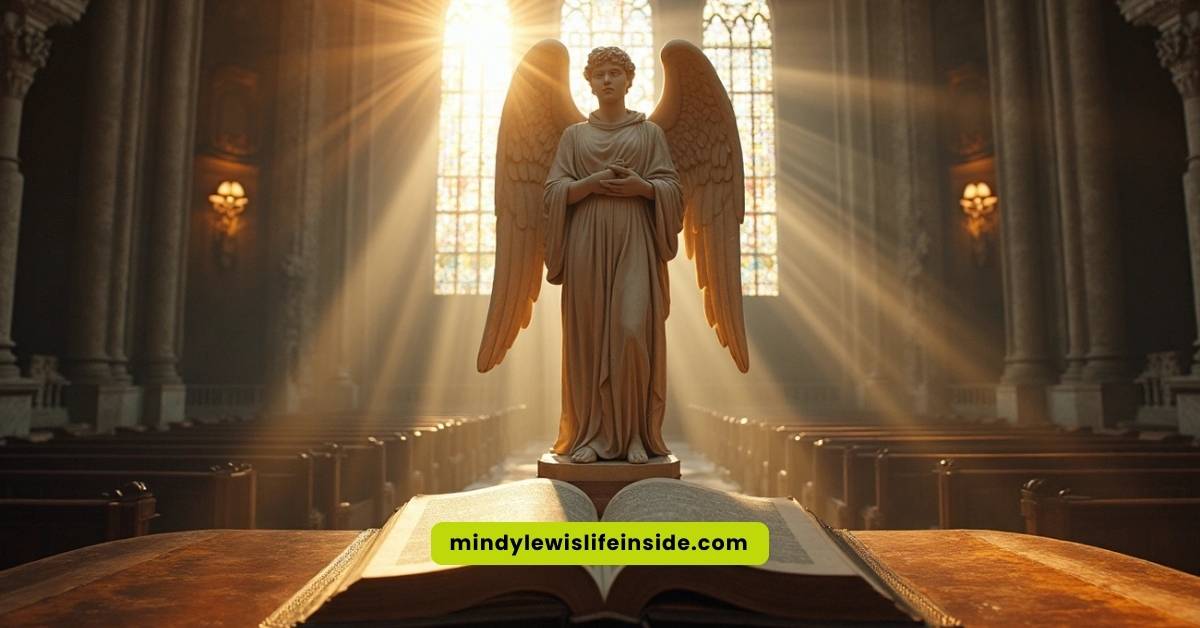Biblical Angels: What Scripture Really Says About These Divine Beings

As an Amazon Associate, I earn from qualifying purchases
I used to think biblical angels were beautiful beings with white wings and glowing halos, but Scripture reveals something far more fascinating. The term “angel” appears close to three hundred times in the Bible, making these divine messengers a significant presence throughout Scripture, not just occasional characters.
According to the Bible, angels are the messengers of God, spiritual beings created to serve divine purposes. The English word “angel” is borrowed from the Greek “angelos,” which literally means “messenger,” and translates the Hebrew word “mal’ak” (also meaning “messenger”).
While popular culture often depicts angels as chubby cherubs or serene human-like figures with wings, how does the Bible describe angels? In Christianity, these celestial beings are affirmed as “ministering spirits sent forth to minister for those who will inherit salvation”, highlighting their primary role as servants rather than the romanticized figures we often see in art.
Interestingly, angels appear about 180 times in the New Testament, compared to just over 100 times in the Old Testament. Throughout Scripture, these divine beings announce significant events, deliver messages, and serve various purposes in God’s plan.
The only angels in the Bible with individual names are all archangels, with three commonly accepted: Michael, Gabriel, and Raphael. Additionally, the Bible describes different types of angels with appearances that might surprise those familiar only with typical Christmas ornaments.
In this article, I’ll explore what Scripture really says about these fascinating celestial beings—from their true appearance and functions to their hierarchy and purpose in God’s divine plan.
What are angels according to the Bible?
The divine beings we know as angels perform crucial roles throughout the Bible’s narrative. Far from being decorative beings with harps and wings, biblical angels serve specific divine purposes with profound theological significance.
Origin of the word ‘angel’
The English word “angel” comes from the Greek angelos (ἄγγελος), which literally means “messenger.” This Greek term translates the Hebrew word malakh (מַלְאָךְ), which carries the identical meaning of “messenger.”
Interestingly, this is more of a job description than a statement about their essence or nature. In both languages, these terms could refer to human messengers in certain contexts, though they primarily designated heavenly beings in Scripture.
The prophet Malachi, whose name incorporates this root word, functioned as God’s messenger to Israel. Furthermore, priests were occasionally called messengers (malakh) of the Lord of hosts, highlighting their communicative role between God and humanity. Essentially, the term doesn’t describe what angels are (spirit beings) but rather what they do (deliver messages).
Angels as messengers of God
Angels primarily function as intermediaries between the divine and human realms. Since God’s power and glory are too overwhelming for direct human interaction, as 1 Timothy 6:16 states, He “dwells in unapproachable light, whom no one has seen or can see”—angels bridge this immense gap between divine holiness and human limitation.
These celestial beings possess intelligence, emotions, and will, making them personal entities rather than impersonal forces. Although they are spirit beings without physical bodies (Hebrews 1:14), they can take physical form when necessary to accomplish their missions.
Angels were created before humans existed. In Job 38:4-7, God describes how “the morning stars sang together, and all the sons of God shouted for joy” during the earth’s creation. Unlike humans, however, angels never die once created (Luke 20:36). Nevertheless, they remain created beings, receiving their existence from God and operating within boundaries He establishes.
Their primary roles include:
- Delivering divine messages
- Executing God’s judgments
- Protecting believers
- Worshipping God continuously
- Strengthening those in spiritual need
Biblical references to angelic appearances
Throughout Scripture, angels typically appear in one of several forms. Most commonly, they manifest as ordinary men, so convincingly human that people often don’t initially recognize their divine nature.
Abraham “entertained angels unawares” (Hebrews 13:2) when three visitors came to his tent at Mamre. Similarly, the angels who visited Lot in Sodom appeared as men.
On other occasions, angels display overwhelming glory. When the angel appeared to the shepherds announcing Christ’s birth, “the glory of the Lord shone around them, and they were filled with great fear” (Luke 2:9). The angels at Christ’s empty tomb had an “appearance like lightning” (Matthew 28:3).
The first recorded angelic appearance occurs in Genesis 3:24, when cherubim with flaming swords guarded Eden’s entrance. Subsequently, angels appeared to Abraham, Hagar, Jacob, Moses, Joshua, Gideon, Manoah, David, Daniel, Mary, Joseph, Peter, and many others throughout biblical history.
Significantly, when humans encountered angels, their reaction was typically fear or awe. This explains why angels commonly began their messages with “Do not be afraid” (Luke 1:13, 2:10). These weren’t the gentle, feminized figures of Renaissance art, but powerful beings whose presence evoked profound reverence.
Types of angels in the Bible
Scripture reveals an intricate hierarchy of celestial beings far more complex than the stereotypical winged humans of popular imagination. The Bible describes various types of angels, each with specific roles in God’s divine order.
Seraphim: Worshipers around God’s throne
The seraphim (meaning “burning ones”) occupy the highest rank in many angel hierarchies. Isaiah 6:1-4 provides our only biblical glimpse of these magnificent beings, describing them with six wings: two covering their faces in reverence, two covering their feet in humility, and two for flying.
Constantly encircling God’s throne, they proclaim His holiness, calling to one another, “Holy, holy, holy is the LORD Almighty; the whole earth is full of his glory”. Their proclamation was so powerful that “the doorposts and thresholds shook and the temple was filled with smoke”.
Notably, the seraphim purified Isaiah’s lips with a burning coal, preparing him for prophetic ministry.
Cherubim: Guardians of sacred spaces
Cherubim first appear in Genesis 3:24, guarding Eden’s entrance with flaming swords after humanity’s fall. Unlike the chubby infants of Renaissance art, biblical cherubim possess multiple faces—those of a human, lion, ox, and eagle—representing different aspects of creation.
Moreover, Ezekiel describes them as covered with eyes, symbolizing vigilance. Cherubim served as guardians throughout Scripture, notably appearing on the Ark of the Covenant where God’s presence dwelt between them. King Solomon incorporated massive cherubim sculptures in the Temple, emphasizing their role as protectors of sacred space.
Thrones and Ophanim: Carriers of divine justice
The Ophanim (Hebrew for “wheels”) appear in Ezekiel’s vision as interlocking wheels covered with eyes. Often identified with the “Thrones” mentioned in Colossians 1:16, these living wheels move with the cherubim because “the spirit of the cherubim is in them”.
Jewish tradition places them in the highest order of angels alongside seraphim and cherubim. These wheels within wheels move in any direction without turning, representing God’s omnidirectional presence and justice throughout creation.
Dominions, Virtues, and Powers: Cosmic administrators
In the middle celestial hierarchy, Dominions govern the movements of celestial objects, including stars and planets. The Virtues control natural elements, assist with miracles, and encourage human faith.
Powers (Greek: exousiai) restrain evil forces from causing harm and oversee earthly authority, including that given to human rulers. Together, these angelic orders maintain cosmic order and implement divine will throughout creation.
Principalities and Archangels: Leaders and protectors
Principalities guide and protect nations, peoples, and institutions like the Church. The Bible mentions only one being explicitly as an archangel—Michael—appearing in Jude 1:9 and leading the heavenly armies against Satan in Revelation 12:7.
Gabriel, though never specifically called an archangel in Scripture, delivered crucial messages, including the announcements of John the Baptist’s and Jesus’s births.
Guardian Angels: Personal guides and protectors
The concept of guardian angels finds support in passages like Psalm 91:11 and Matthew 18:10, which states, “Their angels in heaven always see the face of my Father in heaven”.
Although Scripture doesn’t explicitly declare that each person has an assigned angel, the widespread belief stems from Jesus’s words and the early church’s understanding reflected in Acts 12:15, where believers referred to “Peter’s angel”.
How does the Bible describe angels?
Image Source: Reddit
Biblical angels shatter our modern stereotypes. The majestic beings described in Scripture bear little resemblance to the gentle, robed figures with feathery wings that decorate our Christmas trees and greeting cards.
Physical forms and symbolic imagery
Scripture presents angels in various forms, from humanlike visitors to awe-inspiring celestial beings. Their appearances vary dramatically throughout the Bible, evidently changing based on their missions and God’s purposes.
Sometimes they appear as normal men, as with Abraham’s visitors who “ate the meals” he prepared. In other instances, they manifest as extraordinary beings with “multiple wings, faces, and even fire and lightning surrounding them”.
Ezekiel’s vision describes cherubim with four faces—human, lion, ox, and eagle—symbolizing various aspects of creation. Their entire bodies, “including their backs, hands, and wings, were full of eyes all around, as were their four wheels”. These wheels within wheels moved wherever the spirit directed without turning.
Angels in the Old Testament
In earlier biblical writings, angels frequently appeared in tangible form. The first recorded angelic appearance occurs in Genesis 3:24, when cherubim with flaming swords guarded Eden’s entrance.
Throughout the Old Testament, angels visited key figures, including Abraham, Hagar, and Jacob, typically appearing as men but sometimes displaying overwhelming glory.
Daniel describes an angelic being whose “body was like beryl, his face like lightning, his eyes like flaming torches, his arms and legs like the gleam of burnished bronze”. Isaiah depicts seraphim with six wings, using two to cover their faces in reverence, two for their feet, and two for flying.
Angels in the New Testament
New Testament angels often appear less bizarre yet remain powerful. When angels appeared at Christ’s tomb, they are described as “young men clothed in a long white robe” with an appearance “like lightning”. Throughout the gospels and Acts, angels frequently manifest as men in shining garments.
The Book of Revelation presents the most vivid New Testament descriptions, featuring angels with rainbow-crowned heads, faces like the sun, and feet like pillars of fire.
Fearsome vs. comforting appearances
Regardless of their form, angelic encounters typically evoked profound fear. First, when angels appear to shepherds, prophets, or apostles, their immediate words are often, “Do not be afraid”. This wasn’t merely a courtesy—it was necessary because people were genuinely terrified.
As Scripture makes clear, angels are not the mild, harmless cherubs of popular culture. They are “mighty servants of God, reflecting His glory and power”.
While they occasionally bring comfort, their primary role remains executing divine will with strength and majesty, prompting both awe and reverence from those fortunate enough—or perhaps brave enough—to encounter them.
The role of angels in Christian theology
Image Source: TheCollector
“”Are not all angels ministering spirits sent to serve those who will inherit salvation?”” — The Holy Bible (Hebrews 1:14, NIV), Sacred scripture, foundational to Christian theology
In Christian theology, angels perform several essential functions as divine agents of God’s will. Their multi-faceted roles have profound implications for believers and reveal important aspects of God’s relationship with humanity.
Messengers and mediators
Angels primarily serve as God’s messengers, delivering divine communications to humans throughout biblical history. The apostle Paul confirms that God used angels “to arrange, ordain, and appoint” the law at Mount Sinai. Indeed, they participated actively in the church’s mission, accompanying it in various ways (Acts 5:19-20, 8:26, 10:3).
As mediators, angels bridge the gap between God’s holiness and human limitations. Consequently, they formed a crucial part of the Old Covenant administration, with the cherubim statues “mediating” God’s presence between Himself and Israel.
Warriors and protectors
Michael the Archangel exemplifies the warrior aspect of angelic ministry. As the supreme commander of heavenly hosts, he leads God’s armies in battle against evil forces. Revelation 12:7-8 describes how “Michael and his angels battled against the dragon… but they did not prevail.”
Furthermore, angels protect both individuals and communities. Psalm 91:11 promises that God “will give His angels charge concerning you, to guard you in all your ways.” This protection extends beyond physical safety—angels create “a circle of protection” during prayer.
Worshipers and glorifiers
Angels continuously worship before God’s throne, crying “Holy, holy, holy” without ceasing. Revelation 7:11-12 depicts them falling “on their faces before the throne,” declaring “Amen! Blessing and glory and wisdom and thanksgiving and honor and power and might be to our God forever and ever.”
This perpetual worship reveals their deep humility despite being sinless beings. Their reverence before God serves as a model for human worship.
Ministers to believers (Hebrews 1:14)
Finally, angels function as “ministering spirits sent to serve those who will inherit salvation.” They strengthen believers during spiritual struggles, as one did for Jesus in Gethsemane.
Additionally, they answer prayers, as when Peter was miraculously freed from prison (Acts 12). They even bring our prayers before God, as Raphael declared: “When you and Sarah prayed, it was I who brought the record of your prayers before the glory of the Lord.”
Modern interest in biblical angels
Image Source: inkl
The internet has recently rediscovered what many biblical scholars have known for centuries—angels in Scripture look nothing like their popular representations.
This stark contrast between traditional depictions and biblical descriptions has sparked fascination across digital platforms and beyond.
The ‘biblically accurate angel’ trend
The modern obsession with “biblically accurate angels” traces back to 2016, when a viral Tumblr post by user revolution19 captured the internet’s attention by highlighting that biblical angels aren’t beautiful, soft creatures but rather “Eldritch Abominations straight from our worst nightmares”.
This revelation gained over 420,000 notes, primarily because it shattered preconceived notions about these divine beings. The trend continues to thrive, as people remain captivated by the gap between Scripture’s descriptions and centuries of artistic interpretation.
Social media and pop culture depictions
Currently, TikTok, Twitter, Instagram, and Reddit host millions of engagements with content contrasting traditional angelic imagery against biblical descriptions.
Users create everything from serious theological discussions to humorous memes about the terrifying nature of “accurate” angels. Interestingly, approximately 69% of Americans believe in angels, according to recent polling, making this content relevant to a substantial audience.
Academic and theological debates
Scholarly discussions have emerged alongside popular interest, with theologians and academics debating whether these viral representations truly capture biblical meaning.
Some scholars point out that context matters—different types of celestial beings are often incorrectly lumped together, and many biblical angels appeared as normal humans. Yet this nuance rarely dampens enthusiasm for the more visually striking descriptions.
Christmas decorations and viral content
Firstly, the most tangible manifestation of this trend appeared during the COVID-19 pandemic when Reverend Kira Austin-Young and her puppet-maker husband created a Christmas tree topper featuring a biblically accurate angel.
Their pink, blue, and gold-feathered creation with six wings and dozens of eyes “went a little bit viral”. As Austin-Young explained, “Having a scary and weird angel sort of speaks to people” in troubling times. The design has inspired thousands of DIY versions, becoming the “viral Christmas design trend of 2024″.
Conclusion
Biblical angels clearly transcend the sanitized, romanticized versions we see in popular culture. Throughout Scripture, these divine beings appear as powerful, awe-inspiring messengers with far more complex forms and functions than contemporary art suggests.
Their description as “ministering spirits” in Hebrews 1:14 captures their essence—created beings who serve God’s purposes rather than existing for human comfort.
Furthermore, the stark contrast between the terrifying biblical descriptions and gentle artistic interpretations explains why the “biblically accurate angel” trend continues to captivate our imagination. This fascination reveals our collective yearning to uncover authentic spiritual truths beyond commercialized religious imagery.
Additionally, understanding the diverse angelic hierarchy—from the many-winged seraphim surrounding God’s throne to the wheel-like ophanim covered in eyes—enriches our appreciation of God’s creative power. These beings exist primarily to glorify their Creator and execute His will throughout the cosmos, not to serve as decorative figures on greeting cards.
Though modern interpretations often miss the mark, this renewed interest actually brings people back to Scripture’s text. Previously overlooked passages from Ezekiel, Isaiah, and Revelation now spark theological discussions across digital platforms, breathing fresh life into ancient texts.
Nevertheless, we must remember that despite their magnificence, angels remain created beings, never meant to receive worship themselves.
Their purpose points beyond themselves to the God they serve. Consequently, their fearsome appearance reminds us of the overwhelming nature of divine holiness—something far more powerful than the gentle guardians of popular imagination.
Biblical angels thus stand as profound reminders that spiritual reality exceeds our comfortable categories. Their true nature challenges us to approach Scripture with fresh eyes, ready to encounter the text as it actually exists rather than how we wish it to be. After all, if angels inspire fear and awe, how much more should we approach their Creator with reverence and wonder?
Key Takeaways
Biblical angels are far more complex and awe-inspiring than popular culture suggests, serving as powerful divine messengers rather than gentle decorative figures.
• Biblical angels are primarily messengers (Greek “angelos”) who serve as intermediaries between God and humanity, not the romanticized winged humans of popular art.
• Scripture describes a complex angelic hierarchy including seraphim with six wings, multi-faced cherubim, and wheel-like ophanim covered in eyes—appearances that typically evoked fear.
• Angels function as God’s messengers, warriors, protectors, and worshipers, with their primary role being “ministering spirits sent to serve those who will inherit salvation” (Hebrews 1:14).
• The viral “biblically accurate angel” trend highlights the stark contrast between Scripture’s descriptions and centuries of artistic interpretation, sparking renewed interest in authentic biblical texts.
• Despite their magnificent power and diverse forms, angels remain created beings whose purpose is to glorify God and execute His will, never to receive worship themselves.
This renewed fascination with biblical angels ultimately challenges us to approach Scripture with fresh eyes, ready to encounter spiritual truths that exceed our comfortable expectations and remind us of the overwhelming nature of divine holiness.
FAQs
What are angels according to the Bible?
Angels are spiritual beings created by God to serve as His messengers and carry out His will. They are described in Scripture as powerful, awe-inspiring creatures that often evoke fear when they appear to humans.
Unlike popular depictions, biblical angels can take various forms, from human-like appearances to complex, multi-winged beings covered in eyes.
How many types of angels are mentioned in the Bible?
The Bible describes several types of angels, each with specific roles. These include seraphim (worshippers around God’s throne), cherubim (guardians of sacred spaces), thrones and ophanim (carriers of divine justice), dominions, virtues, and powers (cosmic administrators), principalities and archangels (leaders and protectors), and guardian angels (personal guides and protectors for believers).
Do angels have physical bodies?
Angels are primarily spirit beings without physical bodies. However, they can take on physical forms when necessary to accomplish their missions. In the Bible, angels sometimes appear as ordinary men, while at other times they manifest as extraordinary beings with multiple wings, faces, and even surrounded by fire and lightning.
What is the primary role of angels in Christian theology?
The primary role of angels in Christian theology is to serve as ministering spirits for those who will inherit salvation, as stated in Hebrews 1:14. They function as messengers and mediators between God and humans, warriors and protectors, worshippers and glorifiers of God, and ministers to believers, providing strength and assistance in various ways.
Why has there been a recent surge of interest in “biblically accurate angels”?
The recent surge of interest in “biblically accurate angels” stems from the stark contrast between traditional artistic depictions and the often terrifying descriptions found in Scripture.
This trend, which began on social media platforms, has sparked discussions about the nature of angels and encouraged people to revisit biblical texts. It has also led to creative interpretations in art and even Christmas decorations, as people seek to understand and represent these complex celestial beings more accurately.
As an Amazon Associate, I earn from qualifying purchases









